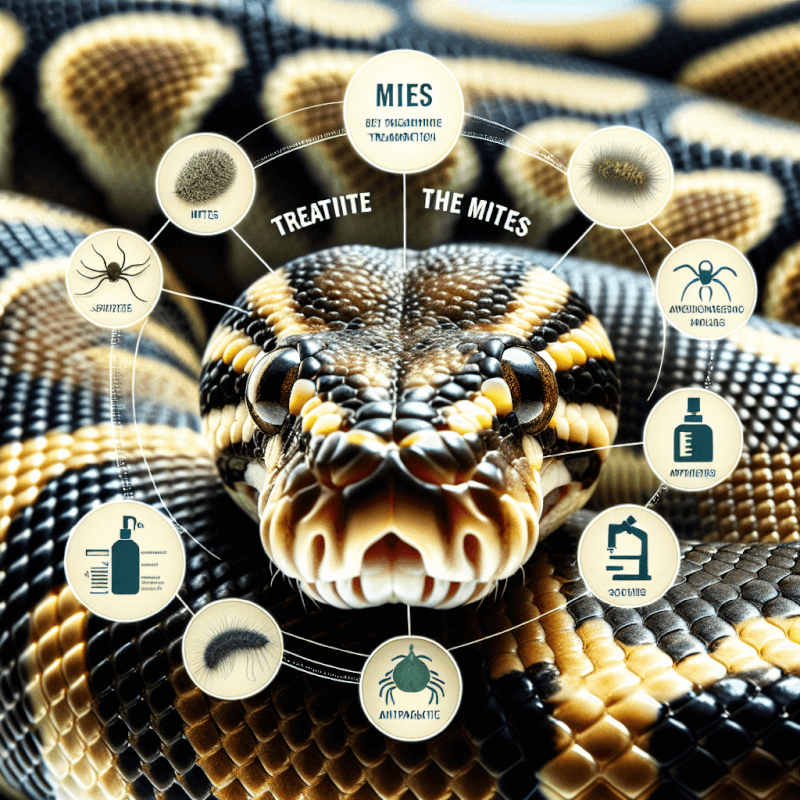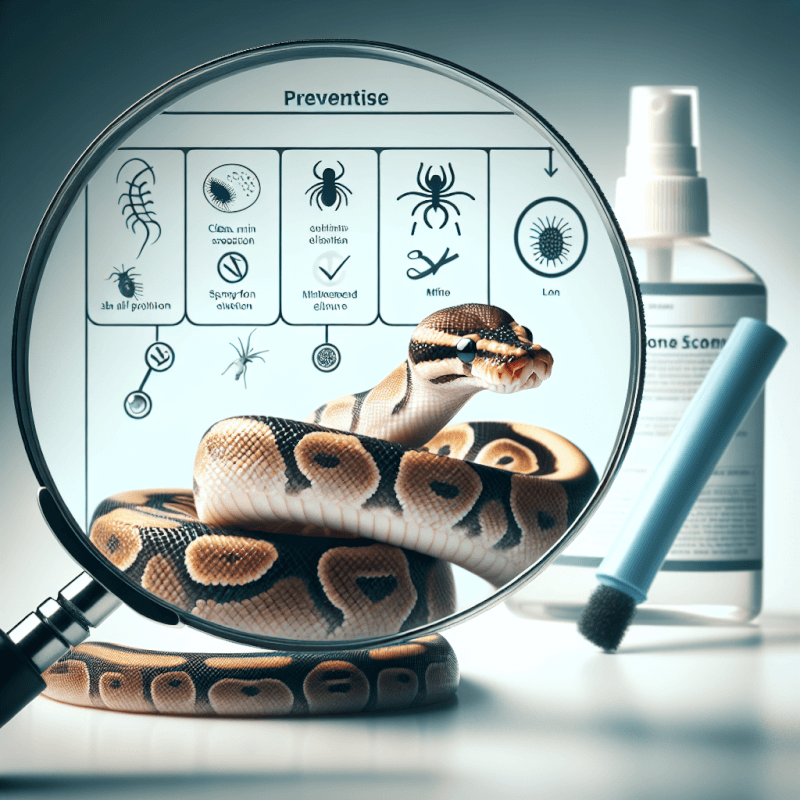So, you’ve noticed that your beloved ball python has fallen victim to the pesky mites. Don’t panic! In this article, we will walk you through the steps on how to effectively get rid of these unwelcome guests and ensure the well-being and happiness of your scaly friend. From identifying the signs of a mite infestation to implementing safe and effective treatment options, you’ll gain the knowledge and confidence to tackle this issue head-on. Your ball python will be back to its vibrant and healthy self in no time!
Identifying Mites in Ball Pythons
Mites are a common issue that can affect ball pythons. These tiny parasites can cause discomfort and health problems for your snake if left untreated. It’s important to be able to identify the signs of mite infestation in order to promptly address the issue and prevent it from spreading.
Clear Signs of Mite Infestation
The first step in treating mites in your ball python is being able to recognize the signs of infestation. Some clear indications that your snake may be dealing with mites include:
- Visible presence of small, black or red dots on the snake’s body, especially around the eyes and mouth.
- Excessive scratching and rubbing against objects in the enclosure.
- Irritated and reddened skin.
- Presence of mite eggs, which resemble small white or transparent specks, in the snake’s habitat.
If you notice any of these signs, it’s important to take action immediately to ensure the health and well-being of your ball python.
Examining the Snake for Mites
To confirm mite infestation, you should carefully examine your snake. Start by gently checking its skin, paying close attention to areas where mites are most commonly found, such as between scales or in skin folds. You can use a magnifying glass to get a closer look.
If you spot any mites crawling on your snake’s body, it’s crucial to take immediate action to prevent the infestation from spreading further.
Using a Mite Trap
Another method of confirming mite infestation is by using a mite trap. Mite traps are small containers that are placed in the snake’s enclosure. They are filled with a special adhesive that captures mites as they move around. By inspecting the trap, you can determine if your snake is dealing with mites.
Mite traps are a valuable tool in monitoring the presence and severity of an infestation. They can also help in identifying the early stages of mite reproduction, allowing you to take timely action to address the issue.
Prevention and Quarantine
Prevention is key when it comes to mite infestations in ball pythons. By implementing proper hygiene practices and quarantine measures, you can significantly reduce the risk of your snake being affected by mites.
Maintaining a Clean Enclosure
Regularly cleaning and disinfecting your snake’s enclosure is essential in preventing mite infestations. You should remove any waste, uneaten food, and shed skin promptly. Thoroughly clean the enclosure with a reptile-safe disinfectant, ensuring that all surfaces are sanitized.
Additionally, consider using appropriate substrates that are less likely to harbor mites, such as paper towels or reptile carpet. Avoid using wood chips or sand, as these materials can provide mites with hiding spots.
Quarantining New Additions
If you’re adding a new snake to your collection, it’s crucial to quarantine them before introducing them to the rest of your collection. Quarantine allows you to observe the snake for any signs of mites or other health issues before potentially exposing them to your other snakes.
During quarantine, keep the new snake in a separate enclosure and closely monitor their overall health. This will help prevent any potential spread of mites to your existing snakes.
Regularly Inspecting Your Snake
In addition to maintaining a clean enclosure and quarantining new additions, it’s essential to regularly inspect your ball python for any signs of mite infestation. By closely examining your snake on a routine basis, you can catch any potential issues early on and take appropriate action.
Look for any telltale signs of mites, such as redness, irritation, or visible parasites on the snake’s body. By being proactive and vigilant, you can prevent mite infestations from becoming a significant problem for your ball python.

Natural Remedies for Mite Treatment
Once you’ve confirmed a mite infestation in your ball python, there are several natural remedies you can use to effectively treat the issue. These remedies can help eliminate mites without exposing your snake to potentially harmful chemicals.
Using a Soapy Water Bath
A soapy water bath is a safe and effective way to eliminate mites from your snake’s body. Fill a shallow container with lukewarm water and add a few drops of mild dish soap. Gently place your snake in the bath and allow it to soak for a few minutes.
While your snake is soaking, use a soft-bristled brush or cloth to carefully remove any visible mites. Be gentle to avoid causing any distress to your snake. After the bath, thoroughly rinse your snake with clean water and ensure it is completely dry before returning it to its enclosure.
Applying Mineral Oil
Another natural remedy for mite treatment is applying mineral oil to your snake’s body. Mineral oil acts as a suffocating agent, effectively smothering mites. Use a soft cloth or cotton swab to apply a thin layer of mineral oil to your snake, paying close attention to areas where mites are commonly found.
Allow the mineral oil to sit on your snake’s body for a few hours before gently wiping it off. Be cautious not to leave any excess oil on the snake, as it can attract dirt and debris. Repeat this process as necessary until the mite infestation is eradicated.
Using Neem Oil
Neem oil is a natural remedy known for its insecticidal properties. It can effectively kill mites while being safe for your ball python. Dilute neem oil with water according to the manufacturer’s instructions and spray it onto your snake’s body. Ensure that you cover all areas where mites are present.
Leave the neem oil on your snake for a short period, usually around 15 minutes, before gently wiping it off with a clean cloth. Repeat this process every few days until the mite infestation is fully resolved.
Chemical Treatments for Mite Infestation
In more severe cases or when natural remedies are not effective, chemical treatments may be necessary to treat mite infestations in ball pythons. These treatments often require the assistance of a veterinarian to ensure proper administration and dosage.
Using Commercial Mite Sprays
Commercial mite sprays specifically formulated for reptiles can be effective in treating mite infestations. These sprays contain chemicals that kill mites upon contact. Follow the manufacturer’s instructions when using a commercial mite spray and carefully apply it to your snake’s body.
It’s important to note that commercial mite sprays may contain chemicals that can be harmful to your snake if not used correctly. Always consult with a reptile veterinarian before using any chemical treatment.
Applying Ivermectin
Ivermectin is a medication commonly used to treat various parasites in reptiles, including mites. It can be administered orally or topically, depending on the severity of the infestation and the recommendation of a veterinarian.
Ivermectin should only be administered under the guidance of a reptile veterinarian, as incorrect dosage or application can lead to potential health risks for your snake. A veterinarian will assess your snake’s condition and provide you with the necessary instructions for using ivermectin.

Treating the Enclosure
Mites can not only infest your snake but also its enclosure. To fully eradicate the infestation, it’s crucial to treat the entire enclosure and remove any potential hiding spots for mites.
Disinfecting the Enclosure
Start by thoroughly disinfecting the entire enclosure using a reptile-safe disinfectant. Pay close attention to all surfaces, including the walls, floor, and furniture. Ensure that the disinfectant is allowed to dry completely before reintroducing your snake.
Regularly disinfecting the enclosure even when not dealing with a mite infestation can help prevent future outbreaks and maintain a clean and safe environment for your ball python.
Replacing Substrates and Hiding Spots
Consider replacing any substrates that may have been infested with mites. Reptile carpet or paper towels are ideal alternatives as they are less likely to provide hiding spots for mites. Avoid using wood chips or sand, as these materials can harbor mites and make it more difficult to eliminate them.
Additionally, carefully inspect all hiding spots, such as caves or log structures, and thoroughly clean or replace them if necessary. By removing mites’ favored hiding places, you can help prevent them from reinfesting your snake’s enclosure.
Washing and Isolating Infected Items
Any items, such as decorations or feeding dishes, that could have come into contact with the mites should be thoroughly washed and disinfected. Cleaning these items will help prevent any re-infestation.
Consider isolating the infected items from the rest of your collection until the mite infestation is fully resolved. This will prevent potential cross-contamination and help contain the problem.
Disposing of Infested Items
In some cases, you may have items that are heavily infested with mites and cannot be effectively treated or cleaned. Properly disposing of these items is crucial to prevent the infestation from recurring.
Properly Discarding Contaminated Items
Seal any heavily infested items in a plastic bag and dispose of them in an appropriate outdoor trash container. Make sure to securely tie the bag to prevent any mites from escaping and potentially re-infesting your ball python’s enclosure or other items.
By properly disposing of heavily infested items, you minimize the risk of future mite infestations and ensure a clean and healthy environment for your snake.
Freezing or Heating Infested Items
Alternatively, you can freeze or heat infested items to kill mites and their eggs. Place the items in a sealed plastic bag and freeze them for at least 24 hours. Alternatively, you can place the bag in direct sunlight for several hours, as the heat will kill the mites and eggs.
However, keep in mind that freezing or heating may not be suitable for all materials, so it’s important to carefully assess the type and condition of the items before using these methods.

Seeking Veterinary Assistance
While many mite infestations can be effectively treated at home, there are instances where seeking veterinary assistance is essential. A veterinarian can provide an accurate diagnosis, prescribe appropriate medications, and guide you throughout the treatment process.
When to Consult a Veterinarian
It’s advisable to consult a reptile veterinarian if the mite infestation persists or if your snake shows signs of distress, such as lethargy, loss of appetite, or unusual behavior. A veterinarian will perform a thorough examination of your snake and may recommend additional diagnostic testing to ensure an accurate diagnosis.
Veterinary assistance is particularly crucial if you are considering using chemical treatments or if you are unsure about the best course of action for treating the mite infestation.
Diagnostic Testing and Medication
A veterinarian may conduct a skin scraping or examine any mite specimens you have collected to identify the specific type of mite infesting your snake. This information will help determine the most effective treatment plan.
In some cases, a veterinarian may prescribe medication, such as topical creams or oral treatments, to address the mite infestation. Always follow the veterinarian’s instructions carefully and complete the full course of treatment to ensure complete eradication of mites and prevent re-infestation.
Precautions and Future Prevention
Taking precautions and implementing proper preventive measures can help minimize the risk of future mite infestations in your ball python.
Isolating Infected Snakes
If you have multiple snakes, it’s essential to isolate any snakes with mite infestations from the rest of your collection. This will prevent mites from spreading to healthy snakes and allow you to focus on treating the affected snake without further complications.
Implementing Regular Cleaning and Examination Routines
Maintaining a regular cleaning and examination routine is key to preventing mite infestations. Schedule regular cleanings of your snake’s enclosure and thoroughly examine your snake for any signs of mites or other health issues.
By being proactive and vigilant, you can identify and address potential issues before they become major problems for your ball python.
Quarantining New Snakes in the Future
Learning from past experiences, it’s crucial to continue quarantining new snakes before introducing them to your collection. By following this practice, you can closely monitor the health of new arrivals and prevent the potential introduction of mites or other infectious agents.
Implementing proper quarantine protocols will help safeguard the health of your existing snakes and maintain a mite-free environment for your ball pythons.

Educating Yourself and Others
To effectively manage and prevent mite infestations, it’s essential to continually educate yourself on ball python health care and share your knowledge with other reptile keepers.
Researching Ball Python Health Care
Dedicate time to researching and staying up-to-date on ball python health care practices. Understand the specific needs and vulnerabilities of ball pythons, including how to identify and treat common issues like mite infestations.
By educating yourself, you will be better equipped to provide the best care for your ball python and effectively navigate any health concerns that may arise.
Sharing Information with Other Reptile Keepers
Sharing information and experiences with other reptile keepers can be valuable in preventing and addressing mite infestations. Engage with online reptile communities, social media groups, or local reptile clubs to exchange knowledge, tips, and advice.
By sharing your own experiences and learning from others, you contribute to a collective effort in maintaining the well-being of ball pythons and other reptiles.
Participating in Reptile Forums and Online Communities
Reptile forums and online communities provide platforms for discussing ball python care and health-related topics. Active participation in these forums allows you to connect with experienced reptile keepers and experts, gaining insights and guidance on mite prevention and treatment.
When sharing your experiences or seeking advice, remember to be respectful and considerate of others’ opinions and viewpoints.
Conclusion
Successfully treating mite infestations in ball pythons requires vigilance, patience, and proper care. By promptly identifying the signs of mite infestation, using natural or chemical remedies, treating the enclosure, and taking preventative measures, you can ensure a mite-free environment and maintain the health and well-being of your ball python.
Remember to seek veterinary assistance when necessary, stay educated on ball python health care, and actively participate in reptile communities to contribute to the collective knowledge and well-being of these beloved reptiles. With proper care, you can effectively treat and prevent mite infestations, allowing your ball python to thrive and flourish in a clean and comfortable environment.



